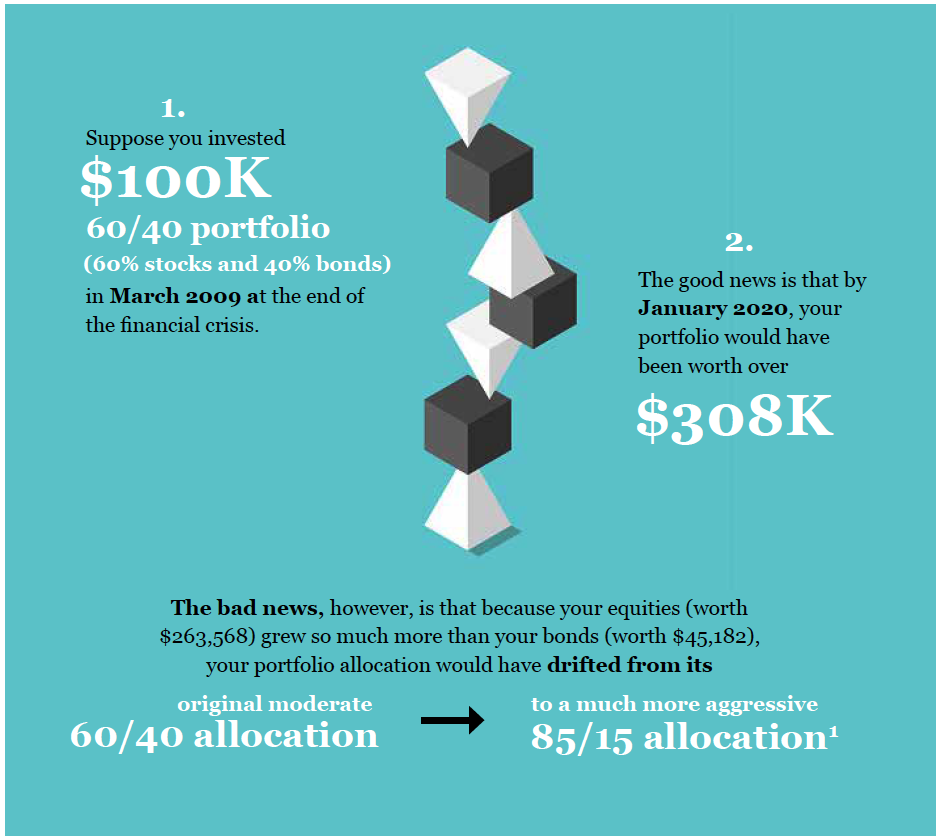Over time, especially during a sustained market run-up or in the aftermath of a major market correction, your portfolio’s asset allocation can gradually, but dramatically, shift from its intended target. Often, this results in a potentially harmful imbalance in which you may unwittingly take on too much risk after the market has soared and too little risk during market lows—the exact opposite of what you had envisioned.
KEY TAKEAWAYS:
Periodic rebalancing is essential to maintaining the appropriate amount of investment risk in your portfolio.
Because different asset classes appreciate or depreciate more quickly than others, your overall asset allocation can drift dramatically over time from your intended target.
There are a variety of rebalancing strategies you may wish to consider and discuss with your financial advisor.
When should you rebalance? There’s no particular advantage to rebalancing at either a market high or at a market low. But both offer particular benefits: rebalancing when the market is high can lessen the impact of the next correction on your savings; and rebalancing after a correction provides an opportunity to harvest some tax losses. Most importantly, rebalancing is about being disciplined and sticking closely to your financial plan by not straying too far from your portfolio’s intended target allocation. To better understand what portfolio drift is and how it occurs, let’s take a look at a hypothetical example:

Eleven years into the longest bull market in U.S. history is not a time where you want to be assuming far more investment risk than you intended. And this same principal holds true in reverse for bear markets. After a precipitous major market correction, a moderate 60/40 portfolio could quickly drift to a more conservative 45/55 allocation — taking on significantly less investment risk (and corresponding growth opportunity) precisely at a time when the market is poised for recovery.
Tax-Smart Rebalancing Strategies
Since rebalancing involves buying and selling investments, it needs to be approached thoughtfully to help minimize transaction costs and avoid triggering any sizable long-term capital gains taxes. Basically, there are three common strategies most frequently employed:
1. Rebalance holistically: Rather than rebalancing each of your portfolios separately, this approach involves looking at all your taxable and tax-deferred portfolios in totality. Just because one portfolio may be out of balance doesn’t necessarily mean your overall allocation isn’t still appropriate.
2. Sweep rather than reinvest: Most people opt to have their dividends and interest reinvested into the purchase of additional shares. However, this can hasten an allocation imbalance in your portfolio. Instead, consider sweeping your dividends and interest into a money market fund. When the time comes to rebalance, you’ll then have cash available to use for additional investment purchases (instead of having to trigger capital gains by selling some of your holdings).
3. Gift highly-appreciated stock: If you’re someone who is charitably inclined, one particularly effective approach to rebalancing is to gift shares of your highly-appreciated stock to a registered 501(c) (3) charity. Not only will this approach avoid triggering any capital gains, but you’ll also receive a charitable deduction on your taxes.
Of course, as with any tax-related investment decisions, you should always consult with your tax attorney before undertaking any rebalancing transactions in order to assess their potential impact.
Rather than focusing on increasing your portfolio’s value, rebalancing is a strategy that’s all about managing your exposure to risk. A good rule of thumb is to try and rebalance your portfolio at least once a year, or whenever a major change occurs to your financial goals, needs or circumstances. However, now may be an ideal time to review your actual versus target allocations and decide on a rebalancing strategy that best fits your needs.

